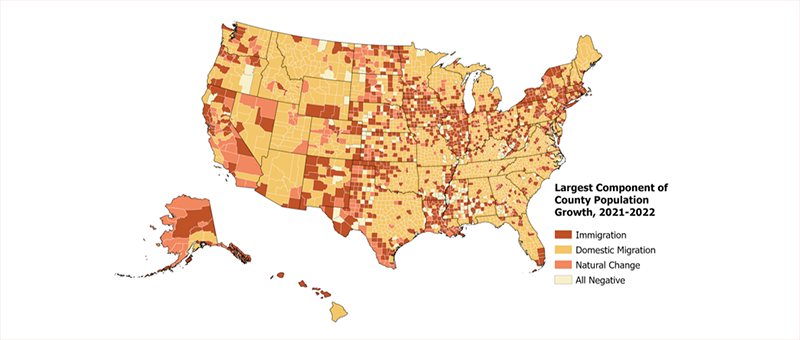A new study from the Joint Center for Housing Studies (JCHS) revealed that the national population growth rate fell dramatically during the pandemic and despite some recovery remained below pre-pandemic levels in 2022, according to their latest State of the Nation’s Housing report.
National growth is dependent on natural change (births minus deaths) and immigration, both of which were barely positive early in the pandemic, which allowed domestic migration to become the key source of growth on the local level.
Immigration levels made a remarkable recovery in 2022, however, and immigrants again became a vital source of growth across the country.
The report shows how variable each component of population change is on the county level. Total population grew in just over half of counties in 2022, while there were more births than deaths in only one-quarter of counties, and positive net domestic migration in nearly two-thirds of counties. Domestic migration continued to play an outsized role in local population change as it was the largest source of growth for a majority (56%) of counties.

Immigration was the largest source of growth for nearly one-third (29%) of counties. In stark contrast, natural population change was the largest source of growth for less than one-tenth (8%) of counties in 2022, and all three sources of population change declined in a similar share (7%) of counties.
Domestic migration became an increasingly important source of population growth in many lower-density counties during the pandemic as the pace of the outflow from large urban areas quickened. Domestic migration was the largest source of growth for the majority of suburban, small or medium metro, and rural counties in 2022. This was especially impactful for rural counties, more than half of which had net domestic inflows in 2022, far exceeding the typical share of one-third of rural counties with net inflows during the 2010s.
Domestic Migration and Immigration Drove Population Growth in Most Counties in 2022
Immigration, on the other hand, was particularly important for urban counties in 2022, serving as the largest source of growth for nearly three-quarters of the central counties of large metro areas. For some of these counties, immigration was key to offsetting losses from domestic migration. In King County, WA, which includes Seattle, where there was a net domestic outflow of 16,000 people that was offset by a net immigration inflow of 23,000 people.
In other counties, especially those in smaller metro areas, immigration was important for stemming losses from natural population change. For example, in Cumberland County, ME, which includes Portland, a net immigration inflow of 1,300 people offsets the natural population loss of almost 500 people.
While natural population change experienced a sharp drop-off due to high death rates from COVID-19, it was already declining before the pandemic and is unlikely to recover substantially due to demographic trends like the aging of the Baby Boom generation.
The Congressional Budget Office projects that while fertility rates will recover slightly and age-adjusted mortality rates will decrease, the population’s composition is such that deaths will outnumber births starting in 2043. At that point, national population growth will be entirely dependent on immigration. In the meantime, domestic migration and immigration are likely to play a central role in the future of population change in cities and towns across the country.
To read the full report, including more data, charts, and methodology, click here.

 theMReport.com Your trusted source for mortgage banking news
theMReport.com Your trusted source for mortgage banking news








